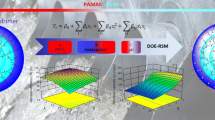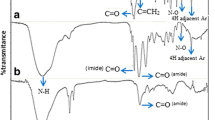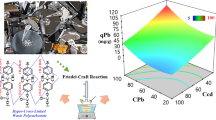Abstract
Heavy metals in drinking water act as contaminants that can cause serious health problems. These metal ions in drinking water are generally removed using cation exchange resins that are used as adsorbents. Generally, chelating resins with limited adsorption capacity are commercially available. Manufacturing novel resin polymers with enhanced adsorption capacity of metal ion requires ample experimental efforts that are expensive as well as time consuming. To overcome these difficulties, application of computer-aided molecular design (CAMD) will be an efficient way to develop novel chelating resin polymers. In this paper, CAMD based on group contribution method (GCM) has been used to design novel resins with enhanced adsorption capability of removing heavy metal ions from water. A polymer consists of multiple monomer units that repeat in a polymer chain. Each repeat unit of the polymer can be subdivided into different structural and functional groups. The adsorption mechanism of heavy metals on resin depends on the difference between activities in adsorbents and the bulk fluid phase. The contribution of the functional groups in the adsorption process is found by estimating the activity coefficient of heavy metal in the solid phase and bulk phase using a modified version of the UNIFAC GCM. The interaction parameters of the functional groups are first determined and then they are used in a combinatorial optimization method for CAMD of novel resin polymers. In this work, designs of novel resin polymers for the removal of Cu ions from drinking water are used as a case study. The proposed new polymer resin has an order of magnitude higher adsorption capacity compared to conventional resin used for the same purpose.







Similar content being viewed by others
References
Agouborde L, Navia R (2009) Heavy metals retention capacity of a non- conventional sorbent developed from a mixture of industrial and agricultural wastes. J Hazard Mater 167(1):536–544
Ali MB, Chabanne RB, Vocanson F, Dridi C, Jaffrezic N, Lamartine R (2006) Comparison study of evaporated thiacalix [4] arene thin films on gold substrates as copper ion sensing. Thin Solid Films 495(1):368–371
Alvarado-Morales M, Terra J, Gernaey KV, Woodley JM, Gani R (2009) Biorefining: computer aided tools for sustainable design and analysis of bioethanol production. Chem Eng Res Des 87(2009):1171–1183
Ang XW, Sethu VS, Andresen JM, Sivakumar M (2013) Copper (II) ion removal from aqueous solutions using biosorption technology: thermodynamic and SEM–EDX studies. Clean Technol Environ Policy 15(2):401–407
Atia AA, Donia AM, Yousif AM (2008) Removal of some hazardous heavy metals from aqueous solution using magnetic chelating resin with iminodiacetate functionality. Sep Purif Technol 61(3):348–357
Atzei D, Ferri T, Sadun C, Sangiorgio P, Caminiti R (2001) Structural characterization of complexes between iminodiacetate blocked on styrene- divinylbenzene matrix (Chelex 100 resin) and Fe(III), Cr(III), and Zn(II) in solid phase by energy-dispersive X-ray diffraction. J Am Chem Soc 123(11):2552–2558
Baraka A, Hall PJ, Heslop MJ (2007) Preparation and characterization of melamine–formaldehyde–DTPA chelating resin and its use as an adsorbent for heavy metals removal from wastewater. React Funct Polym 67(7):585–600
Benavides PT, Diwekar U (2015) Optimal design of adsorbents for NORM removal from produced water in natural gas fracking. Part 1: Group contribution method for adsorption. Chem Eng Sci 137:964–976
Benavides PT, Gebreslassie BH, Diwekar UM (2015) Optimal design of adsorbents for NORM removal from produced water in natural gas fracking. Part 2: CAMD for adsorption of radium and barium. Chem Eng Sci 137:977–985
Berti C, Ulbig P, Burdorf J, Seippel J, Schulz S (1999) Correlation and prediction of liquid-phase adsorption on zeolites using group contribution methods based on the adsorbate solid solution theory. Langmuir 15:6035–6042
Berti C, Ulbig P, Schulz S (2000) Correlation and prediction of adsorption from liquid mixtures on solids by use of GE-Models. Adsorption 6:79–91
Bhagat M, Burgess JE, Antunes APM, Whiteley CG, Duncan JR (2004) Precipitation of mixed metal residues from wastewater utilising biogenic sulphide. Miner Eng 17(7):925–932
Camarda KV, Maranas CD (1999) Optimization in polymer design using connectivity indices. Ind Eng Chem Res 38(5):1884–1892
Chemmangattuvalappil NG, Eljack FT, Solvason CC, Eden MR (2009) A novel algorithm for molecular synthesis using enhanced property operators. Comp Chem Eng 33(2009):636–643
Chen D, Ray AK (2001) Removal of toxic metal ions from wastewater by semiconductor photocatalysis. Chem Eng Sci 56(4):1561–1570
Chen X, Chen G, Chen L, Chen Y, Lehmann J, McBride MB, Hay AG (2011) Adsorption of copper and zinc by biochars produced from pyrolysis of hardwood and corn straw in aqueous solution. Bioresour Technol 102(19):8877–8884
Chouchene A, Jeguirim M, Trouvé G (2014) Biosorption performance, combustion behavior, and leaching characteristics of olive solid waste during the removal of copper and nickel from aqueous solutions. Clean Technol Environ Policy 16(5):979–986
Cox DW (1999) Disorders of copper transport. Br Med Bull 55(3):544–555
Dakova I, Karadjova I, Ivanov I, Georgieva V, Evtimova B, Georgiev G (2007) Solid phase selective separation and preconcentration of Cu(II) by Cu(II)-imprinted polymethacrylic microbeads. Anal Chim Acta 584(1):196–203
Dinu MV, Dragan ES (2008) Heavy metals adsorption on some iminodiacetate chelating resins as a function of the adsorption parameters. React Funct Polym 68(9):1346–1354
Diwekar UM, Kalagnanam JR (1997) Efficient sampling technique for optimization under uncertainty. AIChE J 43:440–447
Diwekar UM, Shastri Y (2011) Design for environment: a state-of-the-art review. Clean Technol Environ Policy 13:227–240
Diwekar, UM, Ulas S (2007) Sampling techniques encyclopedia of chemical technology, vol 1. Wiley, New York
Diwekar U, Xu W (2005) Improved genetic algorithms for deterministic optimization and optimization under uncertainty. Part I. algorithms development. Ind Eng Chem Res 44:7132–7137
Donia AM, Atia AA, El-Boraey H, Mabrouk DH (2006) Uptake studies of copper(II) on glycidyl methacrylate chelating resin containing Fe2O3 particles. Sep Purif Technol 49(1):64–70
Dorigo M, Stutzle T (2004) Ant colony optimization theory. A brandford book. The MIT Press, Cambridge
Dorigo M (1992) Optimization, learning and natural algorithms, Department of Electronics, Politecnico di Milano, Italy, Ph.D Thesis
Dridi C, Ali MB, Vocanson F, Davenas J, Maamar SB, Meganem F, Jaffrezic-Renault N (2008) Electrical and optical study on modified Thiacalix (4) arene sensing molecules: application to Hg2+ ion detection. Mater Sci Eng, C 28(5):765–770
Duran A, Soylak M, Tuncel SA (2008) Poly (vinyl pyridine-poly ethylene glycol methacrylate-ethylene glycol dimethacrylate) beads for heavy metal removal. J Hazard Mater 155(1):114–120
Eljack FT, Eden MR (2008) Systematic visual approach to molecular design via property clusters and group contribution methods. Comput Chem Eng 32:3002–3010
Gebreslassie BH, Diwekar UM (2015) Efficient ant colony optimization for computer aided molecular design: case study solvent selection problem. Comput Chem Eng 78:1–9
Gernaey KV, Gani R (2010) A model-based systems approach to pharmaceutical product process design and analysis. Chem Eng Sci 65:5757–5769
Gupta SS, Bhattacharyya KG (2005) Interaction of metal ions with clays: i. A case study with Pb(II). Appl Clay Sci 30(3):199–208
Harper PM, Gani R (2000) A multi-step and multi-level approach for computer aided molecular design. Comput Chem Eng 24:677–683
Holland JH (1975) Adaptation in natural and artificial systems: an introductory analysis with applications to biology, control, and artificial intelligence. University of Michigan Press, Ann Arbor
Hostrup M, Harper P, Gani R (1999) Design of environmentally benign processes: integration of solvent design and separation process synthesis. Comput Chem Eng 23(1999):1395–1414
Hu X, Li Y, Wang Y, Li X, Li H, Liu X, Zhang P (2010) Adsorption kinetics, thermodynamics and isotherm of thiacalix [4] arene-loaded resin to heavy metal ions. Desalination 259(1):76–83
Inyang M, Gao B, Yao Y, Xue Y, Zimmerman AR, Pullammanappallil P, Cao X (2012) Removal of heavy metals from aqueous solution by biochars derived from anaerobically digested biomass. Bioresour Technol 110:50–56
Jing X, Liu F, Yang X, Ling P, Li L, Long C, Li A (2009) Adsorption performances and mechanisms of the newly synthesized N,N′-di (carboxymethyl) dithiocarbamate chelating resin toward divalent heavy metal ions from aqueous media. J Hazard Mater 167(1):589–596
Juang R-S, Wang Y-C (2003) Ligand-enhanced separation of divalent heavy metals from aqueous solutions using a strong-acid ion-exchange resin. Ind Eng Chem Res 42:1948–1954
Jung MJ, Venkateswaran P, Lee YS (2008) Solvent extraction of nickel (II) ions from aqueous solutions using triethylamine as extractant. J Ind Eng Chem 14(1):110–115
Kantipuly G, Katragadda S, Chow A, Gesser HD (1990) Chelating polymers and related supports for separation and preconcentration of trace metals. Talanta 37:491–498
Kardam A, Raj KR, Srivastava S, Srivastava MM (2014) Nanocellulose fibers for biosorption of cadmium, nickel, and lead ions from aqueous solution. Clean Technol Environ Policy 16(2):385–393
Kazantzi V, Qin X, El-Halwagi M, Eljack FT, Eden MR (2007) Simultaneous process and molecular design through property clustering. Ind Eng Chem Res 46(2007):3400–3409
Kikic I, Fermeglia M, Rasmussen P (1991) Unifac prediction of vapor—liquid equilibria in mixed solvent—salt systems. Chem Eng Sci 46(11):2775–2780
Kim K, Diwekar U (2002a) Efficient combinatorial optimization under uncertainty. 2. Application to stochastic solvent selection. Ind Eng Chem Res 41:1285–1296
Kim K, Diwekar U (2002b) Hammersley stochastic annealing: efficiency improvement for combinatorial optimization under uncertainty. IIE Trans Inst Ind Eng 34:761–777
Kirkpatrick S, Gelatt CD, Vecchi MP (1983) Optimization by simulated annealing. Science 220:671–680
Li M, Harten PF, Cabezas H (2002) Experiences in designing solvents for the environment. Ind Eng Chem Res 41:5867–5877
Lin SH, Lai SL, Leu HG (2000) Removal of heavy metals from aqueous solution by chelating resin in a multistage adsorption process. J Hazard Mater 76(1):139–153
Mahabir S, Spitz MR, Barrera SL, Beaver SH, Etzel C, Forman MR (2007) Dietary zinc, copper and selenium, and risk of lung cancer. Int J Cancer 120(5):1108–1115
Mahdavi S, Jalali M, Afkhami A (2015) Heavy metals removal from aqueous solutions by Al2O3 nanoparticles modified with natural and chemical modifiers. Clean Technol Environ Policy 17(1):85–102
Maranas CD (1996) Optimal computer-aided molecular design: a polymer design case study. Ind Eng Chem Res 35:3403–3414
Maroušek J (2014a) Significant breakthrough in biochar cost reduction. Clean Technol Environ Policy 16(8):1821–1825
Maroušek J (2014b) c. Economically oriented process optimization in waste management. Environ Sci Pollut Res 21(12):7400–7402
Maroušek J, Zeman R, Vaníčková R, Hašková S (2014) New concept of urban green management. Clean Technol Environ Policy 16(8):1835–1838
Maroušek J, Hašková S, Zeman R, Žák J, Vaníčková R, Maroušková A, Vachal J, Myšková K (2015) Techno-economic assessment of processing the cellulose casings waste. Clean Technol Environ Policy 17(8):2441–2446
Marrero J, Gani R (2001) Group–contribution based estimation of pure component properties. Fluid Phase Equilib 184:183–208
Morohashi N, Iki N, Sugawara A, Miyano S (2001) Selective oxidation of thiacalix [4] arenes to the sulfinyl and sulfonyl counterparts and their complexation abilities toward metal ions as studied by solvent extraction. Tetrahedron 57(26):5557–5563
Remenárová L, Pipíška M, Florková E, Horník M, Rozložník M, Augustín J (2014) Zeolites from coal fly ash as efficient sorbents for cadmium ions. Clean Technol Environ Policy 16(8):1551–1564
Ritchie SM, Kissick KE, Bachas LG, Sikdar SK, Parikh C, Bhattacharyya D (2001) Polycysteine and other polyamino acid functionalized microfiltration membranes for heavy metal capture. Environ Sci Technol 35(15):3252–3258
Roy PK, Rawat AS, Rai PK (2003) Synthesis, characterisation and evaluation of polydithiocarbamate resin supported on macroreticular styrene–divinylbenzene copolymer for the removal of trace and heavy metal ions. Talanta 59:239–246
Roy PK, Rawat AS, Choudhary V, Rai PK (2004) Removal of heavy metal ions using polydithiocarbamate resin supported on polystyrene. Indian J Chem Technol 11(1):51–58
Şahan T, Öztürk D (2014) Investigation of Pb(II) adsorption onto pumice samples: application of optimization method based on fractional factorial design and response surface methodology. Clean Technol Environ Policy 16(5):819–831
Samudra AP, Sahinidis NV (2013) Optimization-based framework for computer- aided molecular design. AIChE J 59(10):3686–3701
Satyanarayana KC, Gani R, Abildskov J (2007) Polymer property modeling using grid technology for design of structured products. Fluid Phase Equilib 261:58–63
Satyanarayana KC, Abildskov J, Gani R, Tsolou G, Mavrantzas VG (2010) Computer aided polymer design using multi-scale modeling. Braz J Chem Eng 27(03):369–380
Schluter M, Gerdts M (2010) The oracle penalty method. J Global Optim 47:293–325
Schluter M, Gerdts M, Ruckmann JJ (2012) A numerical study of MIDACO on 100 MINLP benchmarks. Optimization 61:873–900
Shek TH, Ma A, Lee VK, McKay G (2009) Kinetics of zinc ions removal from effluents using ion exchange resin. Chem Eng J 146(1):63–70
Sundaram A, Venkatasubramanian V (1998) Parametric sensitivity and search- space characterization studies of genetic algorithms for computer-aided polymer design. J Chem Inf Comput Sci 38(6):1177–1191
Suzuki M (1990) Adsorption Engineering. Elsevier Science Publishing Company, INC, New York
Uchimiya M, Lima IM, Thomas Klasson K, Chang S, Wartelle LH, Rodgers JE (2010) Immobilization of heavy metal ions (CuII, CdII, NiII, and PbII) by broiler litter-derived biochars in water and soil. J Agric Food Chem 58(9):5538–5544
Ucun H, Aksakal O, Yildiz E (2009) Copper(II) and zinc(II) biosorption on Pinus sylvestris L. J Hazard Mater 161(2):1040–1045
Venkatesan G, Senthilnathan U, Rajam S (2014) Cadmium removal from aqueous solutions using hybrid eucalyptus wood based activated carbon: adsorption batch studies. Clean Technol Environ Policy 16(1):195–200
Xu W, Diwekar U (2005) Improved genetic algorithms for deterministic optimization and optimization under uncertainty. Part II. Solvent selection under uncertainty. Ind Eng Chem Res 44:7138–7146
Yamamoto H, Tochigi K (2008) Computer-aided molecular design to select foaming agents using a neural network method. Ind Eng Chem Res 47:5152–5156
Zecchin A, Simpson A, Maier H, Leonard M, Roberts A, Berrisford M (2006) Application of two ant colony optimization algorithms to water distribution system optimization. Math Comput Model 44:451–468
Zhu Y, Hu J, Wang J (2012) Competitive adsorption of Pb(II), Cu(II) and Zn(II) onto xanthate-modified magnetic chitosan. J Hazard Mater 221:155–161
Author information
Authors and Affiliations
Corresponding author
Rights and permissions
About this article
Cite this article
Mukherjee, R., Gebreslassie, B. & Diwekar, U.M. Design of novel polymeric adsorbents for metal ion removal from water using computer-aided molecular design. Clean Techn Environ Policy 19, 483–499 (2017). https://doi.org/10.1007/s10098-016-1236-6
Received:
Accepted:
Published:
Issue Date:
DOI: https://doi.org/10.1007/s10098-016-1236-6




